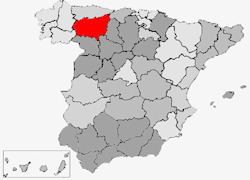 | ||
León is one of the 52 electoral districts (Spanish: circunscripciones) used for the Congress of Deputies, the lower chamber of the Spanish Parliament, the Cortes Generales. It was first contested in modern times in the 1977 General Election. Notable former deputies include the former Prime Minister of Spain José Luis Rodríguez Zapatero.
Contents
Boundaries and electoral system
Under Article 68 of the Spanish constitution the boundaries must be the same as the province of León and under Article 140 this can only be altered with the approval of congress. Voting is on the basis of universal suffrage in a secret ballot. The electoral system used is closed list proportional representation with seats allocated using the D'Hondt method. Only lists which poll 3% or more of all valid votes cast, including votes "en blanco" i.e. for "none of the above" can be considered for seats. Under article 12 of the constitution, the minimum voting age is 18.
León is the largest city with 108,000 voters, just over one-quarter of the total electorate of 414,000 on 1 May 2008, with the next largest municipalities being Ponferrada (54,000 voters), San Andrés del Rabanedo (24,000) and Villaquilambre (12,000). There were no other municipalities with more than 10,000 voters.
Eligibility
Article 67.3 of the Spanish Constitution prohibits dual membership of the Cortes and regional assemblies, meaning that candidates must resign from Regional Assemblies if elected. Article 70 also makes active judges, magistrates, public defenders, serving military personnel, active police officers and members of constitutional and electoral tribunals ineligible.
Number of members
In the general elections of 1977, 1979 and 1982 León returned 6 members. That figure was reduced to 5 members for the 1986 election and it has stayed at that figure since then.
Under Spanish electoral law, all provinces are entitled to a minimum of 2 seats with a remaining 248 seats apportioned according to population. These laws are laid out in detail in the 1985 electoral law. (Ley Orgánica del Régimen Electoral General) The practical effect of this law has been to overrepresent smaller provinces at the expense of larger provinces.
In 2004 Spain had 34,571,831 voters giving an average of 98,777 voters per deputy. In León the ratio was slightly below that at 90,556.
Summary of seats won 1977–2016
Note: Seats shown for the PP include seats won by their predecessors, the Popular Alliance and Popular Coalition before 1989. Seats shown for Podemos include the Unidos Podemos coalition in 2016.
2008 General Election
The PSOE obtained their best ever result in the district in 2008, polling an absolute majority for the first time. This had last been achieved by the UCD in the 1979 election. The city of León itself produced a result close to the district average with the PSOE polling 48.3% against 44.4% for the PP. In Ponferrada, PSOE led PP by 51.2% to 42.3%
2004 General Election
The PSOE narrowly outpolled the Popular Party in the 2004 Election. This was the first time since 1989 that this had happened in any of the nine electoral districts in the region of Castile and León.
2000 General Election
† Núñez was replaced by María García Arias on 13 November 2001.
Source:
